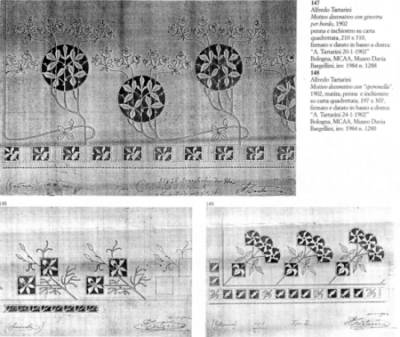Aemilia Ars is an exquisite needlelace, it was created during the period of Renaissance in Italy. Between the end of the XIX and early XX century, was born a prestigious school of applied art that promoted the upgrading Crafts .
Aemilia Ars Workshop founded in Bologna in 1898 by the Alfonso Rubbiani (1848ò1913) , artist, architect, restorer, designer, poet and lawyer in order to recover, distribute and market the arts in Emilia. This initiative was supported by Count Francesco Cavazza, other nobles and in particular by the Countess Lina Cavazza, noblewoman that from her personal collection was made available antique lace for the study and revival of the now lost techniques.
Countess Lina Cavazza, besides devoting herself to numerous charitable works, committed herself to generating a female industry which could guarantee well-paid work to women and at the same time affirm social and human values.
Modelled on the English Arts and Crafts Movement its formal name was Società Cooperativa Aemilia Ars. At first the workshop produced a wide range of products, including glass and pottery, but from 1902 to 1914 its principal product were textiles, especially lace. This firm was the first to link the archeological recovery of styles – especially Renaissance – with its experience in restoration.
In the field of embroidery and lace, Aemilia Ars first of all retraced its sources, such as the old pattern-books by Antonio Tagliente (Esempio di ricami, 1528), or by Nicolò Aristotele (Universali dei belli ricami, 1530), and then studied antique paintings in order to reproduce the lace works depicted therein.
Old needlepoints were revived, for example the a reticella point of the fifteenth century, which had enjoyed great popularity in France since the reign of Henry IV.
The “visible architecture” of this point revealed its Italian origin even in the copies made foreign lacemarkers; a quality which was enhanced even further in the late nineteenth and early twentieth centuries, a period which Ojetti judged as being “without style”. At the Milan Exhibition of 1906, Aemilia Ars displayed the philological skill of its workers by exhibiting to the Piccolomini family.
In the early 900s, during the two world wars, Bologna was protagonist of an economic miracle called “aemilia ars”.
Characterized by a technical virtuosity equal or superior to that of the earlier models that inspired it, this activity represents the only expression of the liberty style in the sector.
The bolognese exhibition is intended as a contribution and stimulus to the classification, recovery, and conservation of a part of the city’s heritage still too little known.
The memory of this work is entrusted to insufficiently appreciated collections surviving in schools of music, women’s training institutes, and professional schools, as well as in church and private collections.
Source: www.comune.bologna.it


I am interested in receiving information to learn about this technique.